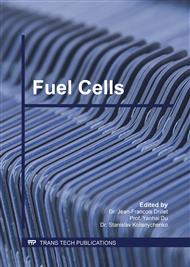p.810
p.815
p.820
p.826
p.832
p.838
p.843
p.849
p.855
Surface Engineering of Metal Oxide Photoelectrodes for Improved Band Alignment in Solar Water Splitting Cells
Abstract:
Several earth-abundant transition-metal oxides (e.g. Fe2O3, CoO, and Cu2O) possessing suitable band gaps for solar water splitting exist, but energy level alignment is often sub-optimal, i.e. the conduction and valence bands do not straddle the water oxidation and reduction potentials. Here, using a nanocrystalline-TiO2-based photoelectrochemical cell as a model system, we investigate the effect of tuning the semiconductor energy levels by adding Li+ ions to the electrolyte. The effect of LiClO4 addition on band edges, interfacial recombination resistance, electron diffusion length, and charge-separation efficiency were quantified by impedance spectroscopy and analysis of incident photon-to-current efficiency spectra. We find that the TiO2 band edges are shifted toward positive potentials by the addition of Li+, and that this increases the apparent electron diffusion length without affecting the charge-separation efficiency, most likely due to a change in the driving force for O2 reduction. These results should prove useful in the modeling and optimization of solar water splitting cells employing metal oxide photoelectrodes.
Info:
Periodical:
Pages:
832-837
Citation:
Online since:
November 2016
Authors:
Price:
Сopyright:
© 2017 Trans Tech Publications Ltd. All Rights Reserved
Share:
Citation:



